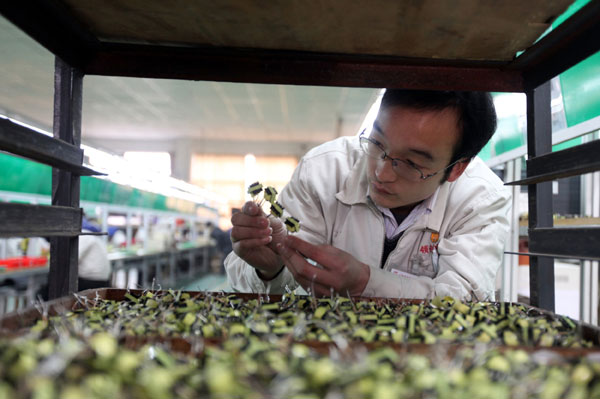Workforce shortage a structural problem
Updated: 2012-04-16 08:04
By Hu Yuanyuan (China Daily)
|
|||||||||||
Economic restructuring
In February, the Ministry of Human Resources and Social Security said that the average monthly salary for migrant workers reached 2,049 yuan nationally in 2011, a rise of 21.2 percent from the previous year. That increase accompanied a year-on-year rise of 4.4 percent in the number of rural migrant workers, with the number hitting 252.78 million at the end of 2011, said Yang Zhiming, deputy minister of human resources and social security.
The rapid rise in wages for migrant workers has weighed heavily on enterprises and prompted them to move up the value chain. Fang said her company's profit margin narrowed by more than 10 percent last year because of rising labor costs and declining sales. "We are now developing new products to attract customers in emerging markets as demand from Europe and the United States continues to fall," Fang said. "But the rising costs of labor and raw materials will remain a huge challenge for us in 2012."
As a medium-sized manufacturer of vacuum cleaners, Ningbo Shentong's labor costs have risen nearly 20 percent this year, Fang added. "This year, we've invested heavily in product innovation in the hope that high-end products will bring a wider profit margin to offset rising costs," she said.
Sun Chi, an economist at Normura Securities, said that rising wages will force companies to move up the value chain and boost total-factor productivity, a term economists use to describe the amount of total output that is not fully explained by the amount of input. The government has pushed for such a move for many years, but businesses had little incentive to do so while they could tap such a vast pool of cheap labor.
On the other hand, rising wages have also helped to stimulate consumption and fuel the transformation of the Chinese economy from one driven by exports to a model that's more reliant on increased internal consumption. According to a report by Normura, the decades-long decline of the household share of national income reflects China's traditional cheap-labor advantage. But if labor shortages now lead to rapid wage growth, especially among low-income groups, household consumption is likely to boom because low-income households have a greater propensity to spend.
China's labor shortage will be a long-term problem, rather than a short-term concern, according to some economists. Stephen Green, an economist at Standard Chartered Bank who specializes in China, said the growth rate of new jobs will exceed the increase in the number of workers and the situation will deteriorate during the coming decade. "We estimate that the growth rate of the labor population will be close to zero in the coming years, so improving efficiency is key to sustaining economic growth," said Green.
According to Nomura, the proportion of the population aged 10 to 19, the "pipeline workforce", has fallen steadily over the past two decades from 19.9 percent to 13.5 percent, while that of workers in the 50 to 59 age bracket (the official retirement age being 60 for men and 55 for women) has increased from 7.8 percent to 14 percent.
This development suggests that the proportion of the workforce to the population as a whole is close to peaking. "These labor market trends are intricately linked to China's ongoing economic restructuring and are helpful in sustaining growth," said Sun.
 |
|
A worker checks the quality of products at an electronics factory in Huaying city, Sichuan province. Like Li Xiaohong in Henan, he also benefits from free technical training. [Qiu Haiying / for China Daily] |











